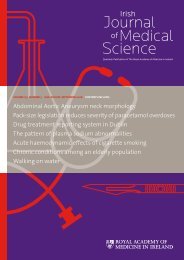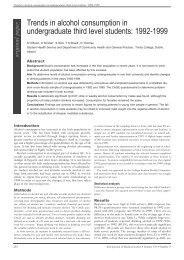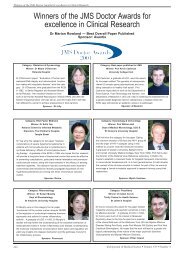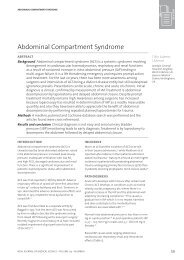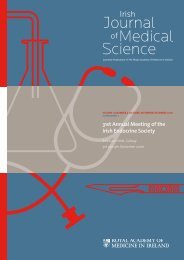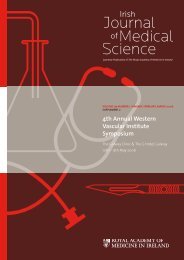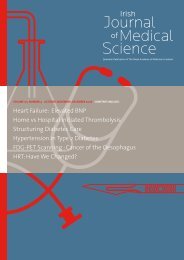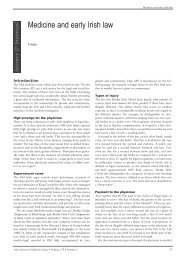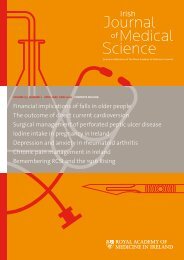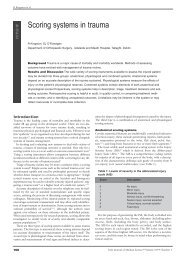Annual General Meeting of the Irish Thoracic Society - IJMS | Irish ...
Annual General Meeting of the Irish Thoracic Society - IJMS | Irish ...
Annual General Meeting of the Irish Thoracic Society - IJMS | Irish ...
You also want an ePaper? Increase the reach of your titles
YUMPU automatically turns print PDFs into web optimized ePapers that Google loves.
31<br />
1<br />
SESSION THREE ONE<br />
ANNUAL MEETING OF THE IRISH THORACIC SOCIETY • 11 - 12 November 2005 • WESTWOOD HOUSE HOTEL, GALWAY<br />
Session 3: Poster Discusssion Session<br />
ANNUAL MEETING OF THE IRISH THORACIC SOCIETY • 11 - 12 November 2005 • WESTWOOD HOUSE HOTEL, GALWAY<br />
3<br />
SESSION<br />
SESSION THREE ONE<br />
COPD<br />
3.1<br />
Long term oxygen <strong>the</strong>rapy use in Ireland; audit <strong>of</strong> a<br />
regional hospital<br />
Introduction<br />
An audit <strong>of</strong> <strong>the</strong> use <strong>of</strong> long-term oxygen <strong>the</strong>rapy<br />
(LTOT) in an <strong>Irish</strong> Regional Hospital.<br />
Methods<br />
Retrospective review <strong>of</strong> patients who were initiated<br />
on LTOT at <strong>the</strong> Midland Regional Hospital Mullingar<br />
between 2002 and 2004<br />
Research<br />
Data from 108 patients was reviewed. The mean age<br />
<strong>of</strong> <strong>the</strong> population was 68 years; 54% were male. 33%<br />
<strong>of</strong> <strong>the</strong> patients were actively smoking tobacco up until<br />
<strong>the</strong> time <strong>of</strong> initiating LTOT. Eighty five <strong>of</strong> <strong>the</strong> patients<br />
(79 %) had a diagnosis COPD as <strong>the</strong> reason for <strong>the</strong>ir<br />
hypoxaemia. Only 36% <strong>of</strong> <strong>the</strong> patients had pulmonary<br />
function tests performed, though <strong>the</strong> majority <strong>of</strong><br />
patients (85%) had arterial blood gases taken.<br />
3.2<br />
Unmet daily needs <strong>of</strong> COPD patients<br />
Introduction<br />
The effects <strong>of</strong> exacerbation <strong>of</strong> COPD can remain<br />
long after <strong>the</strong> acute phase has passed. It impacts<br />
not only on lung function but also on Activities <strong>of</strong><br />
Daily Living (ADLs) and emotional well-being. One<br />
month following discharge, 30% <strong>of</strong> elderly patients<br />
still have compromised mobility and 90% are unable<br />
to perform all household chores. Early Supported<br />
Discharge (ESD) schemes for COPD patients attempt<br />
to provide medical, nursing and social support<br />
in <strong>the</strong>ir own homes during <strong>the</strong> acute phase and<br />
many schemes report short term outcomes such as<br />
reduced length <strong>of</strong> hospital stay. However, it is not<br />
always clear if <strong>the</strong> longer-term needs <strong>of</strong> patients<br />
have been addressed.<br />
Method<br />
Review <strong>of</strong> documentation used by Foyle &<br />
Altnagelvin ESD scheme to assess <strong>the</strong> effectiveness<br />
<strong>of</strong> nursing interventions in relation patients longterm<br />
needs.<br />
Results<br />
89 patients’ (46F/43M) records between Nov. 2004<br />
- July 2005 were analysed. Mean age was 68yrs (51-<br />
Very few patients had <strong>the</strong>ir LTOT prescribed by GP’s<br />
(3%), <strong>the</strong> remainder having <strong>the</strong>ir oxygen prescribed<br />
by general and chest physicians. All patients had a<br />
back-up cylinder <strong>of</strong> oxygen provided, and 84% had<br />
concentrators; only a third (36%) had been provided<br />
portable oxygen. Though <strong>the</strong> concentration <strong>of</strong> oxygen<br />
had been prescribed in <strong>the</strong> majority (91%), only 79%<br />
had <strong>the</strong> duration <strong>of</strong> <strong>the</strong>rapy specified. 86% <strong>of</strong> <strong>the</strong><br />
patients were followed up in clinic; however, only 42%<br />
<strong>of</strong> <strong>the</strong>m were re-evaluated for continued need for<br />
LTOT. None <strong>of</strong> <strong>the</strong> patients had <strong>the</strong>ir LTOT withdrawn.<br />
Conclusion<br />
LTOT is presently not being properly prescribed.<br />
Appropriate follow-up is also inadequate.<br />
85 years), 24% lived alone, 34% never left <strong>the</strong>ir home,<br />
36% were on LTOT and 48% had long term assistance<br />
with personal care.<br />
Nurse referrals for Long-term Personal Care = 9%,<br />
for ADL equipment = 60%, for Occupational Therapy<br />
assessment for adaptations =19%, for Specialist<br />
Nursing & PAMs input =15%, for pulmonary<br />
rehabilitation = 27% and miscellaneous referrals =10%.<br />
Conclusions<br />
This review highlighted that nursing follow-up <strong>of</strong><br />
patients in <strong>the</strong>ir home can identify and address<br />
deficiencies in care and social support for COPD<br />
patients. Therefore, we would recommend that a<br />
home assessment <strong>of</strong> post exacerbation patients, who<br />
feel disabled, is an essential component <strong>of</strong> holistic<br />
COPD management.<br />
I Kamal, A O’Brien<br />
Midland Regional<br />
Hospital Mullingar,<br />
Co. Westmeath<br />
A Box, M Logue,<br />
A Kennedy,<br />
M McCloskey, M Kelly,<br />
JG Daly, RA Sharkey<br />
Foyle Trust, Abercorn<br />
Road, Derry, Dept <strong>of</strong><br />
Respiratory Medicine,<br />
Altnagelvin Hospital,<br />
Derry<br />
3.3<br />
Lung volume reduction surgery: an unmet need?<br />
Therapeutic options for patients with severe COPD<br />
are limited but lung volume reduction surgery<br />
(LVRS) has been proposed for selected patients with<br />
severe emphysema. The procedure involves <strong>the</strong><br />
bilateral resection <strong>of</strong> diseased lung through a median<br />
sternotomy. There is no established LVRS programme<br />
in Ireland. We report two patients with heterogeneous<br />
emphysema who underwent LVRS urgently following<br />
development <strong>of</strong> acute respiratory failure.<br />
Case 1<br />
A 48-year-old ex-smoking male was admitted with an<br />
exacerbation <strong>of</strong> COPD. He had received conventional<br />
treatment including pulmonary rehabilitation. Despite<br />
intensive treatment he failed to improve and proceeded<br />
to bilateral LVRS. He made a successful recovery.<br />
Preoperative and postoperative PFTs are shown.<br />
3.4<br />
Introduction<br />
In Beaumont Hospital, exacerbations <strong>of</strong> COPD<br />
account <strong>of</strong> 10% <strong>of</strong> total medical admissions. These<br />
patients are <strong>of</strong>ten ill-prepared for <strong>the</strong>ir transition<br />
from hospital to home. Our aim is to identify <strong>the</strong><br />
benefits <strong>of</strong> an assisted discharge programme for<br />
this patient group who were ineligible for our COPD<br />
Outreach Programme.<br />
Method<br />
An initial inpatient assessment was completed<br />
by <strong>the</strong> Outreach team. An average <strong>of</strong> two home<br />
visits with follow-up phone calls over a two week<br />
period was carried out. Outcome measures included<br />
spirometry and Borg breathlessness scale.<br />
Emphasis was on medication compliance, education<br />
Case 2<br />
A 53-year-old ex-smoking male was admitted with an<br />
exacerbation <strong>of</strong> COPD in March 2005. Similarly he had<br />
received conventional treatment including pulmonary<br />
rehabilitation. He had known ischaemic heart<br />
disease. Despite intensive treatment he remained in<br />
respiratory failure dependent on NIV. He proceeded<br />
to LVRS. This was complicated by a post-operative<br />
cardiac arrest. The patient was slowly mobilized but<br />
deteriorated and died 111 days postoperatively.<br />
Both patients had been considered for LVRS electively<br />
but in <strong>the</strong> absence <strong>of</strong> an established programme<br />
<strong>the</strong>y only proceeded to surgery when <strong>the</strong>y acutely<br />
deteriorated. We conclude that an elective LVRS<br />
programme is needed in Ireland.<br />
PREOPERATIVE<br />
POSTOPERATIVE<br />
FVC 3.88 (72%) 4.25 (92%)<br />
FEV1 1.57 (42%) 2.87 (76%)<br />
TLCO 13.88 (43.86%) 18.36 (58.38%)<br />
TLC He. Dilution 6.71 (95.05%) 6.39 (90.48%)<br />
FRC 3.59 (103.7%) 3.12 (89.71%)<br />
TLC Body Plethysmography 9.25 (130.9%) 7.06 (99.9%)<br />
ITGV 6.36 (183.6%) 3.65 (104.8%)<br />
The efficacy <strong>of</strong> an assisted discharge programme for<br />
patients with chronic obstructive pulmonary disease<br />
– a necessary expansion <strong>of</strong> COPD outreach services at<br />
Beaumont Hospital<br />
and life-style changes including smoking cessation,<br />
coping mechanisms and self management plans.<br />
Results<br />
Over six months (January to July 2005), a total <strong>of</strong><br />
24 patients were recruited. 12 Males and 12 Females<br />
with a mean age <strong>of</strong> 78 (± 8.6). Mean FEV 1<br />
% predicted<br />
- 35% (± 14.2). Median Borg score 0.5 (±1.1). Median<br />
MRC 2. Average length <strong>of</strong> stay 7.3 days (± 6.1). 80% <strong>of</strong><br />
patients, post discharge, required fur<strong>the</strong>r community<br />
referrals by <strong>the</strong> team for example: provision <strong>of</strong> home<br />
oxygen and social services.<br />
Conclusion<br />
An assisted discharge service bridges <strong>the</strong> gap<br />
between hospital and community by providing a<br />
safe, seamless transition home for COPD patients.<br />
BB Shu, M Connor,<br />
G Lawless, M Tolan,<br />
TJ McDonnell<br />
Depts <strong>of</strong> Respiratory<br />
Medicine and <strong>Thoracic</strong><br />
Surgery St Michael’s<br />
and St Vincent’s<br />
University Hospital,<br />
Dublin<br />
JM Shortt, CC Byrne,<br />
BM Deering, SJ O’Neill,<br />
NJ McElvaney,<br />
RW Costello<br />
Dept <strong>of</strong> Respiratory<br />
Medicine, Beaumont<br />
Hospital Dublin<br />
22 IRISH JOURNAL OF MEDICAL SCIENCE • VOLUME 174 • NUMBER 4 • SUPPLEMENT 3<br />
IRISH JOURNAL OF MEDICAL SCIENCE • VOLUME 174 • NUMBER 4 • SUPPLEMENT 3 23




